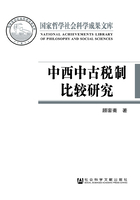
Abstract
This book, composed of the general discussion and the separate discussion, is meant to study issues of taxation between China and Western Europe in the Middle Ages in a comparative way. The general discussion explores the basic theories of taxation, while the separate discussion focuses on the tax systems. As the basis of tax collection, expenditure and management, the tax theories consist of two layers. One is the deep-layered theories inherited from centuries and threaded through the whole Middle Ages, which represent the basic features and spirit of the tax system of the society; the other is the superficial-layered theories, referring to the specific theories derived from the basic theories of taxation. This book refers the deep-layered theories as the basic theories of taxation, while the superficial-layered theories as the specific theories. By proposing the basic theories of taxation, I intend to use a new interpreting means applicable both in China and in the west to throw light on the inner track of medieval taxations between China and Western Europe, explore the controlling force of the basic theories of taxation on the practice and evolution of tax systems, and analyze the history of the development and evolution of taxations of China and Western Europe in the Middle Ages. In the process of the discussion, I strive to emphasize the logical relations between the basic theories of taxation, the basic problems of taxation, and the interrelationships among the basic problems so as to make each part into an organic whole.
Chinese basic theories of taxation include two parts, that is, Patriarchy and Monarchy Theories and Doctrines of Family-Governed Monarchic Country and“Monarch's Land and Subjects”. The basic theories of taxation in the Middle Ages in Western Europe consist of three parts: common interest, common necessity and common consent. The formation of the basic theories of taxation has its own inner track. In Chinese ancient cultural mode, it started from patriarchal system, and then developed into monarchy and absolute monarchy system. Patriarchal system played an important role in the formation of the basic theories of taxation. Contrary to Chinese traditional culture, western tradition was the mixture of Classic Culture, Christian Culture and Germanic Culture, which bred and gave birth to the social customs and the system of common negotiation and consent. Under the restrictions of the different basic theories of taxation, different tax systems were generated in China and Western Europe and thus had different tracks of development.
On the basis of the concept of the basic theories of taxation, I further propose the concept of tax right. Tax right is the synthesis of the ownership of the right of setting tax, the right of tax usage and the audit right, which is the inevitable reflection of the basic theories of taxation. In China, tax right rested with centralized government and belonged to the emperor. The central government organized the activities, such as tax collection, tax usage and tax audit. The concept of tax right was raised in Western Europe in the Middle Ages. Tax right by and large belonged to a certain authoritative group. With the development of the Chinese society in the Middle Ages, Chinese emperors had been increasingly strengthening their control of the tax right, while in Western Europe parliaments began to hold the tax right. In the later medieval history, with the unprecedented consolidation of autocratic monarchy system, Ming and Qing dynasties made improvements in minor aspects of taxation system and perfected the system as a whole by simplifying the taxes and strengthening auditing, thus eventually made the tax right centralized into the control of the emperors. Tax right varied in different countries in Western Europe, but on balance, the strengthening of kingship did not result in the fundamental changes to parliamentary monarchy and the tax right was still in the hands of Parliaments. Even in the countries where the king could control the tax right, the king was still constrained by some local authoritative groups when exercising the tax right.
After reading a variety of original historical sources and studying a great many case studies within my reach, I proposed and explored a series of problems, such as the concept of the basic theories of taxation, differences and similarities of the basic theories of taxation in the Middle Ages between China and Western Europe, the ownership and exercise of the tax right, the collection, expenditure and management of tax, the evolution and change of main tax items, tax organizations, tax structure, special tax items and tax laws, the quality of commodity tax and tariff and their relationship with the seeds of capitalism and the evolution of the history of taxation in China and Western Europe in the Middle Ages. Through the discussion of these problems, we hope to find the answers to the following questions: why did they have quite different economic policy systems in China and Western Europe though they both developed from the traditional agricultural society? How to understand the traditional conclusion that agricultural countries in the Middle Ages would inevitably make the agricultural tax as the basis of the government revenue? Does the conclusion achieve the universal meaning? In addition, all these questions are part of the basic questions in taxation system, so the discussion and exploration of these questions will further and deepen the comparative study of taxation systems between China and Western Europe in the Middle Ages.